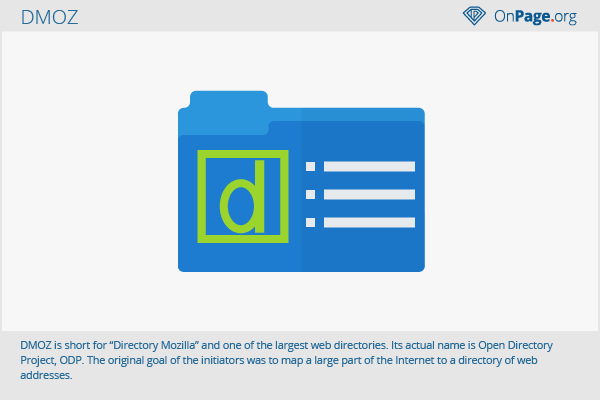DMOZ
DMOZ is short for “Directory Mozilla” and it used to be one of the largest web directories. Its official name was "Open Directory Project", ODP. The original goal of the initiators was to map a large part of the internet to a directory of web addresses. What was special about DMOZ was that it had no commercial background and was maintained by volunteer editors. For a long time, Google used the meta description that were part of the DMOZ description of a web page for the snippets in the SERP. On March 17, 2017, the DMOZ project was ended by its operator, AOL.
Background
The Open Directory Project (ODP) was started in the summer of 1998 by founders Rich Skrenta and Bob Truel. At that time, the directory was called Gnuhoo, and shortly after, Newhoo. However, just four months after its launch, Newhoo was bought by Netscape and renamed to Open Directory Project. After Netscape was acquired by AOL and AOL merged with Time Warner, the project was supported by these large enterprises until its completion.[1]
The name DMOZ is composed of the first address of the directory: directory.mozilla.org. From then on the domain dmoz.org was used for the entire directory. One goal of DMOZ was to make information more readily available to users. During its inception it wasn’t as easy as it is today to get relevant information on websites, for example through Google search. Google itself was still in its infancy. Moreover, DMOZ was a non-commercial model of a web directory that did not rely on automatic entries like many other directories. The content on DMOZ was subject to “Open Content” guidelines and could therefore be shared and used, without infringing upon copyright laws. This fact resulted in rapid dissemination of this directory.
The content was edited and published by volunteer editors. One editor usually handled a specific set of topics. Until its demise, DMOZ was available in over 60 different languages. However, the volunteers could barely keep up with the rapid development of internet content and there were often delays in the updating of each category. In February 2017, AOL business group announced its intention to end the web directory, an announcement that surprised its users. In March 2017, DMOZ was shut down indefinitely.
A static copy of dmoz.org still exists. On this site,[2] users can still search for entries, but there is no editing and no new entries will be added.
Structure
The ODP was organized by topic and country/region. Any webmaster could register their website there, but editors could reject an application if it did not meet the requirements.
An entry in DMOZ always consisted of a title, which was linked to the registered website and a brief description. The target URL was also displayed. If a user searched for a specific term with the search bar, they saw the matching entries that could also be narrowed down by topic or region respectively.
Requirements for entry
The user would find a suitable category on dmoz.org and then click on the link “Propose URL.” An input field then opened up in which all relevant data for the domain was entered. The description itself was very short and included a minimum of 25 and a maximum of 30 words.
If a user wanted to make sure that their chosen category would be edited regularly, they had to check the date of the last update at the bottom of the page. If this was several years in the past, one could assume that there was no longer an editor assigned to this category. If an entry was checked by an editor, he/she would have either released or rejected it.
Since DMOZ was maintained manually, this web catalog was considered a trusted source by Google. Until 2011, Google had its own web directory which built on the data of the ODP and served to enrich its own search index.
Google used DMOZ to generate SERPs snippets, for example, for websites, where the search engine was not able to identify any information itself. If you did not want Google and other search engines to rely on the DMOZ databases, you would have noted this in the meta data with NOOPD. Such an indication is no longer necessary.
DMOZ and SEO
A listing on DMOZ was considered to be a “secret weapon” by SEOs for a long time. Because of the high quality of the manually maintained directory, a backlink from the ODP was certainly an important indicator for Google as well. However, over the years Google, like other search engines, has vastly improved its algorithms and this rendered an entry in this directory almost irrelevant.
With several hundred ranking factors, one backlink is only just one link and a single link in a number of many backlinks is in turn only a single aspect of the link profile. The question of the importance of DMOZ for SEO is repeatedly discussed, however, in SEO circles. Regarding the question “Is DMOZ dead?” there were more than six million search hits on Google. Now the question can be answered by a simple "yes", because the directory no longer exists in its current form.
The OPD editor "tschild" now administers the domain dmoz.de at his own expense and informs users about the end of dmoz.org. He had volunteered for the ODP for 19 years, and was shocked at the decision to end DMOZ.
References
- ↑ DMOZAccessed on March 23, 2018
- ↑ dmoztools.netAccessed on 18.07.2017
Web Links

